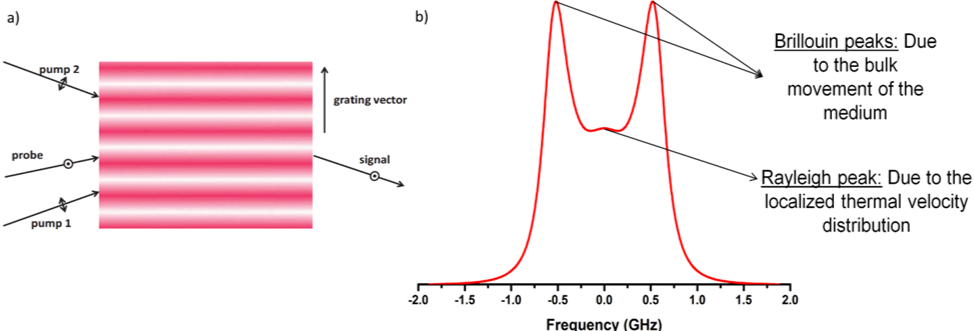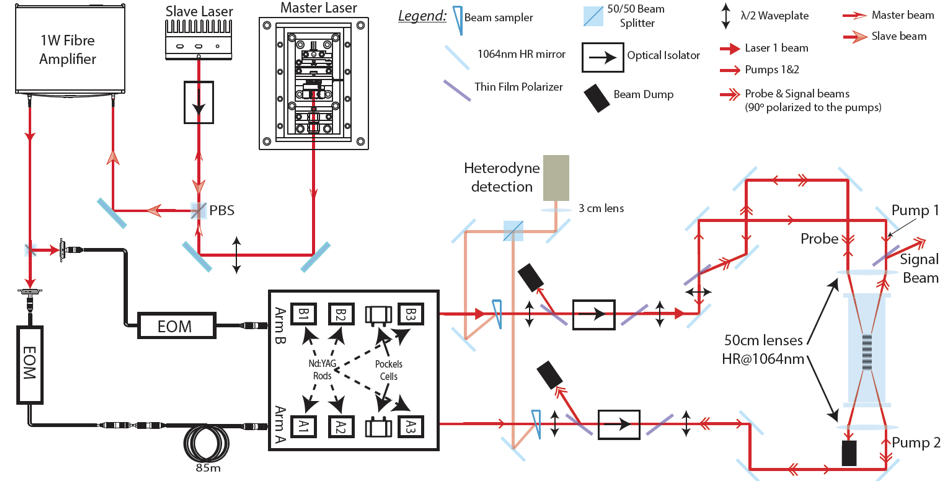Coherent Rayleigh-Brillouin Scattering (CRBS)

CRBS relies on the creation of periodic refractive index (i.e. density) gratings within a medium. These periodic refractive index (and density) modulations are created by the interference of two laser beams, called the pumps, within the medium. The frequency difference of the two pump beams is linearly changed such that it creates interference patterns of different velocity (top figure on left). Due to the ponderomotive force, particles of the medium will concentrate in the high intensity regions of this interference pattern, thus giving rise to a so-called optical lattice. A third beam, called the probe, is incident upon this lattice at an angle fulfilling the Bragg relation and is coherently scattered from it. The result of this process is a fourth beam, called the signal. By measuring the intensity of the signal beam with respect to the velocity of the optical lattice we obtain the Rayleigh-Brillouin spectrum (top figure on right). A CRBS spectrum consists of a spectroscopic triplet: the Rayleigh peak, centered at zero velocity/frequency difference and Doppler broadened due to the thermal motion of particles, and the two Brillouin peaks, equidistant to the Rayleigh peak and symmetrical to it, due to the collective movement of the particles, centered at the speed of sound of the medium.

In PPPL, we have designed and developed a laser system, which has already demonstrated its capability of obtaining a single shot CRBS spectrum in a gas or gas mixture, and have shown how this can be used for remote gas pressure and polarizability measurements . More importantly, we have used the same laser system in order to probe volumetric nanoparticle formation in a graphitic arc discharge, where we have been successful in determining in situ the presence and mass of nanoparticles in the arc discharge environment. A schematic of the CRBS system can be seen in sketch of the experimental setup, shown above. The system starts with an in-house designed and built Nd:YVO4 microchip laser, which hosts an intracavity LiTaO3 electro-optic modulator (EOM). By applying a voltage to the EOM we’re effectively changing the laser cavity length and thus the frequency of the laser output. This step allows, ultimately, for the creation of chirped optical lattices that result in the acquisition of the CRBS spectrum in a single laser shot. The output of this laser is injection seeded on a 1064 nm laser diode in a master-slave configuration in order for the exhibited relaxation oscillations of the master laser to be suppressed. The output of the slave laser is then amplified by an Ytterbium based commercial fiber amplified and split in two, while a chopping of the CW beam in two pulses follows: the second pulse would have a frequency difference with respect to the first pulse and when these two interfere they will result in the desired chirped lattices. These two laser pulses are finally seeding the respective inputs of a triple stage diode pumped amplifier. With this laser system we achieve frequency excursions up to ±1.5 GHz with energies per pulse of up to 250 mJ/pulse in a pulse duration between ~150-200 ns. This is the only CRBS currently in operation worldwide, capable of obtaining a CRBS spectrum in a single laser shot.